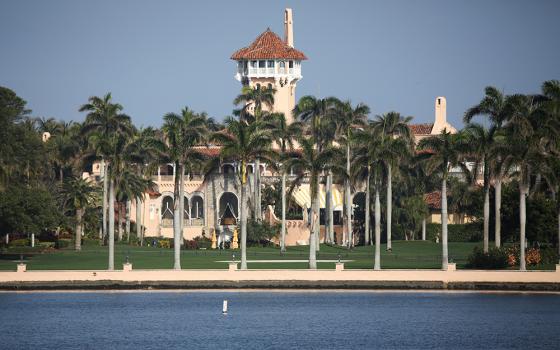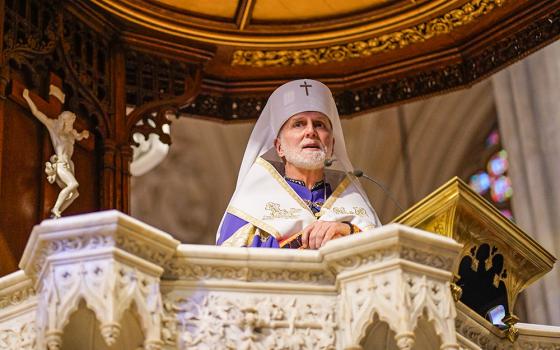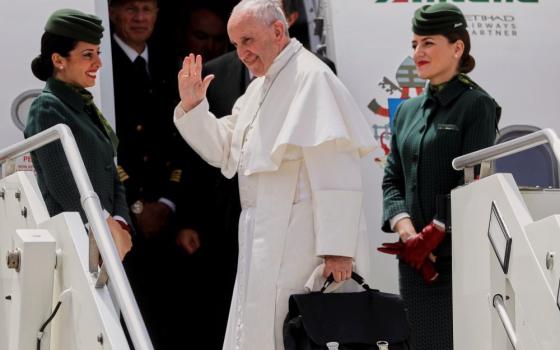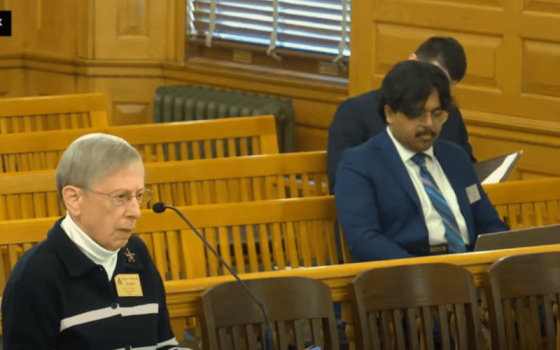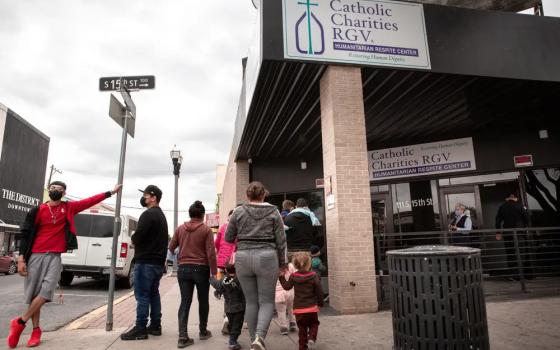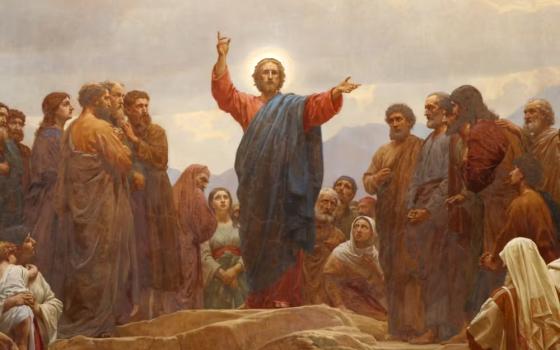Bishop Mark J. Seitz of El Paso, Texas watches as migrants disembark at Lajas Blancas, Panama, amid their journey through that nation's Darién Gap, during the bishop's pastoral visit amid the 10th Meeting of Bishops and Migration Pastoral Agents of North America, Central America and the Caribbean, which took place Aug. 19-23 in Panama. (OSV News/courtesy of Bishop Mark J. Seitz)
Bishop Mark J. Seitz of El Paso, Texas, recently spoke with OSV News following his return from the 10th Meeting of Bishops and Migration Pastoral Agents of North America, Central America and the Caribbean, which took place Aug. 19-23 in Panama.
The gathering — which focused on the theme "Walking with the migrant and the refugee" — included a Mass with Cardinal Michael Czerny, prefect of the Vatican Dicastery for Promoting Integral Human Development, and a pastoral visit to the Darien Gap. The remote region, located on the border between Colombia and Panama, has become a major and deadly migration route, as thousands navigate its rugged, dense terrain while also battling crime and disease.
This interview has been edited for clarity and length.
OSV News: What was your overall experience at the migration meeting?
Seitz: I've certainly met with some of these bishops in the past, and we had a meeting last year in El Salvador. It was a bigger group this time, with something like 22 bishops on hand.
The opportunity to meet and to reflect on these issues, and to talk about what kind of pastoral letter we might write, was very worthwhile — even though we ended up without having (completed) a pastoral letter, because we realize that project is going to take a lot more work.
Certainly the most moving part of the week was when I had the opportunity to go with a small group down to the Darien Gap. So many of our immigrants that have passed through El Paso had to pass through there to arrive (at the U.S.-Mexico border), with immigrants from Venezuela and Ecuador being the primary groups.
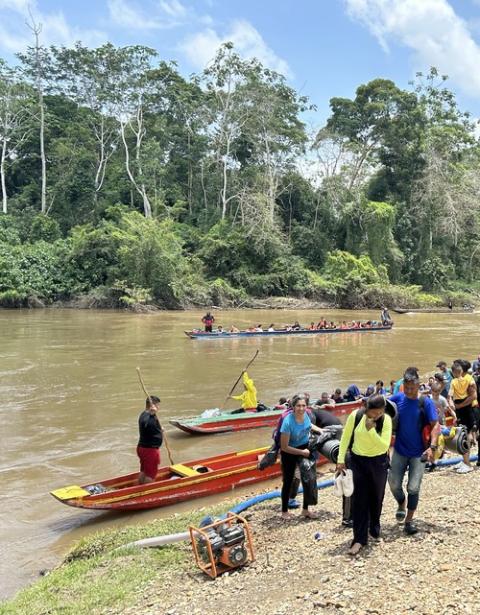
Migrants disembark at Lajas Blancas, Panama, amid their journey through that nation's Darien Gap. (OSV News/courtesy of Bishop Mark J. Seitz)
OSV News: The Darien Gap has proven to be one of the world's most difficult and deadliest migration routes. How did you get there, and what was it like seeing a portion of it in person?
Seitz: The Panamanian government actually offered to take us down to the Darien Gap. They flew us down in a small military plane, and we landed on an airstrip in the Darien in a place called Meteti.
There were about eight of us (bishops) in total. Our group included Cardinal Michael Czerny, prefect of the Vatican Dicastery for Promoting Integral Human Development; Cardinal Álvaro Leonel Ramazzini Imeri, Bishop of Huehuetenango (Guatemala); Archbishop José Domingo Ulloa Mendieta of Panama; and Bishop Pedro Joaquin Hernández Cantarero of the Apostolic Vicariate of Darien.
Regarding the Darien Gap itself, I'd seen pictures, I'd seen some videos, but it's not the same as being there. The northern part of it that we saw seemed to be a mixture of pasture land and forest or jungle. We went by car farther south from Meteti to a place called Lajas Blancas.
We arrived at a little spot on the river where a bit of rustic community has sprung up. They have some little stores that provide just necessities. There is a Red Cross (station) — a very rustic place with a metal roof, but no walls, where people can spend the night. There is also a place to park buses that will ultimately take those who can pay the $60 a person from that spot north to the northern border of Panama.
We walked down to the river, which is fairly wide and rapidly flowing, and we saw these narrow boats that seem to be just put together by hand, just about as wide as a canoe. They have a little outboard motor on them so that they can go upstream, and each boat takes about 15 people.
And one after another, these boats were depositing people who had made the trek through the most rugged part of the Darien to this outpost. A lot of them were unsteady on their legs and needed a little help getting out of the boat. I saw the feet of a number of them; they're bloodied and blistered. And the children seemed — some of the babies seemed kind of listless.
You could see the suffering in their faces, and it was very moving.
Many of them asked me to bless them. I wanted to do something more, but I didn't know what I could do for them. So you feel that kind of frustration.
As Catholics, whatever you might think is the best solution for immigration situations, you cannot leave aside that awareness of the fundamental human dignity of a person, and you cannot in conscience send one of these children of God back to a place where they're going to very likely suffer great harm.
OSV News: How can the Catholic Church accompany migrants in a way that addresses the trauma that drives them from their homelands and that they suffer during their journey?
Seitz: That's a very good question. Many migrants have been sexually violated on the way; many of them have been kidnapped and beaten. Even kids are being kidnapped now in Mexico, especially in northern Mexico.
One of the things that we're supporting with the fund that we created in El Paso is to be able to assist with psychological services for those particularly traumatized by their experience. We have set up a medical clinic that features such services.
The bishop of the Darien told us they haven't been able to set up any charitable services operated by the church in outposts where refugees are passing through, since he only has 11 priests in this whole region, which is the largest region of Panama. There are little towns with mostly Indigenous people there, and they're doing the best just to serve those.
I was thinking that maybe we can find some funding to build a little chapel at one or two of these locations — because for people who do have this journey, their faith is all they have in a certain way, but their faith is powerful, and it's the only thing that really gets them through.
So we as a church certainly want to let them know that the Lord is with them in these circumstances, and we want to remind them that we love and care for them as children of God.
OSV News: Under international law, the principle of non-refoulement protects individuals from being returned to situations where their life or freedom would be endangered. How can the church help to uphold this principle?
Seitz: To put it in simple terms, I think the church — wherever we are — needs to be the conscience of the community and for the governments of the places where we (as Catholics) dwell.
That means that we have a responsibility to speak prophetically in light of the Gospel about the dignity of the human person, and the responsibility that we have to every human person.
I think we need to continually remind people in power about that. As Catholics, whatever you might think is the best solution for immigration situations, you cannot leave aside that awareness of the fundamental human dignity of a person, and you cannot in conscience send one of these children of God back to a place where they're going to very likely suffer great harm.
Advertisement
OSV News: How can the Catholic Church raise awareness of the root causes driving people to undertake perilous and very often deadly migration journeys?
Seitz: No discussion of the immigration situation should simply focus on the border. To really understand the situation and respond to it, we have to take into account the situation in the sending countries.
And we need to do that not only from a moral point of view, in terms of the care that we have for everyone as children of God, but in terms of the morality of recognizing that we bear some responsibility for the situation in many of these sending countries, particularly those of Latin America — because the narco-trafficking organizations in those countries are very often causing much of the violence, with (the organizations' activities) funded by our appetite in this country for illegal drugs.
We're funding (the narcotraffickers), we're sending money to them, and we're sending guns to them across our border.
So we certainly need to address these issues in our country for our own people's sake, but also for theirs. At the same time, we need to help these countries respond to combat these destructive issues that are sending people ultimately fleeing to our border.
